| Home | Manuscripts | Top-10 Lists | e-World | Site Index |
|
The Best of Sherlock Holmes |
www.bestofsherlock.com/ref/museum-london-2014.htm
Sherlock Holmes Manuscripts & Rarities:
The Museum of London 2014 Exhibition
By Randall Stock, October 17, 2014 (revised May 10, 2015)
The most extensive exhibition of Sherlock Holmes rarities in sixty years opened at the Museum of London on October 17, 2014. It includes Conan Doyle's first notes about the great detective, Holmes manuscripts from four different decades, original Holmes drawings by Sidney Paget, rare first editions, and much more.
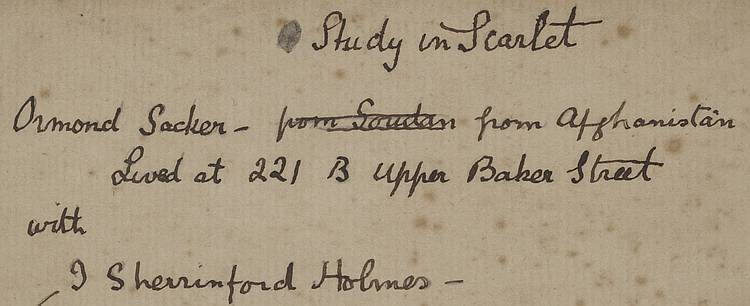
Notes for A Study in Scarlet with alternate names for Holmes and Watson
Manuscript Highlights (by date)
The Museum of London exhibition includes Conan Doyle's earliest notes for the first Sherlock Holmes story, the first page from the oldest Holmes manuscript still in existence, and three complete Holmes story manuscripts.
Approximately two-thirds of the Holmes manuscripts are known to exist, although some of these include only fragments. For a complete list, see the Sherlock Holmes Manuscript Census.
Visitors should note that these manuscripts appear in various sections of the exhibition.
The Murders in the Rue Morgue (manuscript, 1841)
Often credited as the first detective fiction short story, this tale by Edgar Allan Poe helped to inspire the creation of Sherlock Holmes. Conan Doyle called Poe "the supreme original short story writer of all time," and referred to Poe's detective, C. Auguste Dupin in his own notes for A Study in Scarlet.

Three manuscript pages, with the top of the first showing a change to the story title.
Lent by the Colonel Richard Gimbel Collection, Rare Book Department, The Free Library of Philadelphia.
Photo © The Free Library of Philadelphia.
Southsea Notebooks: Notes for A Study in Scarlet (1885 or 1886)
Conan Doyle's three "Southsea notebooks" (1885-1889) contain more than 300 pages of literary, historical, and philosophical notes. They include the first lines ever written on Sherlock Holmes, with the author's preliminary title of "A tangled skein" crossed-through and replaced with the final version "A Study in Scarlet." For more details, see Study in Scarlet facsimile #112, and Lot 19 on the Census of the Conan Doyle Collection.

Three Southsea notebooks, with Holmes notes shown here.
Lent by Dr. Constantine Rossakis.
Photo © Private Library of Constantine Rossakis, M.D.
Notes for A Study in Scarlet (1885 or 1886)
Sometimes described as the "Sherlock Holmes birth certificate," this famous page of notes headed "Study in Scarlet" shows Conan Doyle originally named his detective as "Sherrinford Holmes" and his partner as "Ormond Sacker." It includes references to Afghanistan, 221B, and Baker Street. Shown in the 1951 Festival of Britain Holmes Exhibition (item 12), but rarely seen in the last 50 years. With a handwritten note by his son Adrian Conan Doyle. To see a photo of the entire page of notes, including references to Edgar Allan Poe's detective C. Auguste Dupin, visit my Origins of Sherlock Holmes manuscript page.

One leaf of Arthur Conan Doyle notes plus comments from his son.
Lent by the heirs of Anna Conan Doyle.
Photo © Courtesy of the Conan Doyle Estate.
The Sign of the Four (manuscript, 1889)
The first page from the oldest surviving Sherlock Holmes manuscript begins with the detective injecting himself with a seven-per-cent solution of cocaine. Originally published in February 1890 in Lippincott's Magazine as The Sign of the Four, Conan Doyle later shortened the title to simply The Sign of Four. The title shown below was added in pencil by someone else, probably an editor.
This leaf became separated from the rest of the manuscript, and Conan Doyle later wrote out a second copy in order to make a complete manuscript. A private collector holds that "fair copy" with the remainder of the manuscript, but this leaf is the earlier version. For more details about both versions, see The Sign of the Four facsimiles #101 & #103. See also these 2014 articles in The Daily Mail and in The Guardian.
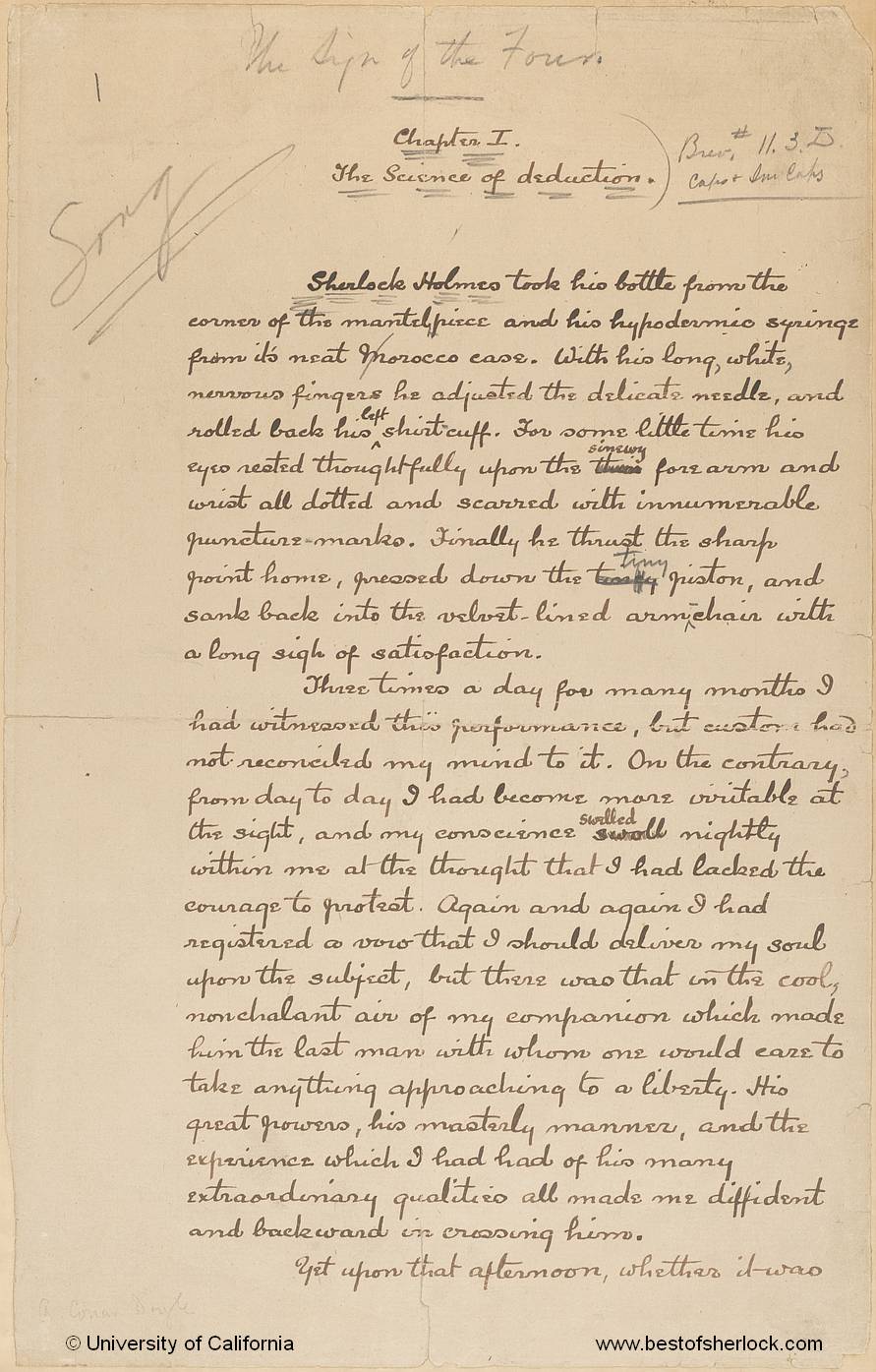
One manuscript leaf, with editing pencil marks.
Lent by the University of California, San Diego.
The Empty House (manuscript, 1903)
Conan Doyle killed off Holmes in 1893, but in 1901 wrote The Hound of the Baskervilles and set it before the detective's death. Two years later he received a lucrative offer to bring Holmes back from the dead in a new series that eventually ran to thirteen stories.
He completed the first of that series, "The Adventure of the Empty House," by early April 1903, and explained that Holmes had faked his death in the battle with Professor Moriarty at the Reichenbach Falls. Conan Doyle had the manuscript bound and donated it in 1916 for an auction to raise funds for the British Red Cross. Famed bookseller A.S.W. Rosenbach later purchased it for his own personal collection.
For more details, see my chapter "Unlocking 'The Empty House'" in Out of the Abyss, from the BSI Manuscript Series facsimile for this story (available from the BSI website).
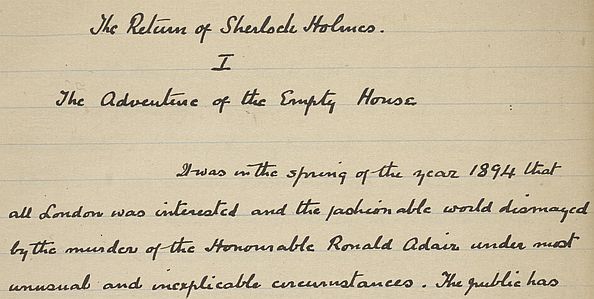
Complete manuscript, 47 pages, bound.
Lent by the Rosenbach of the Free Library of Philadelphia.
Arthur Conan Doyle, The adventure of the empty house: AMs, [1903]
(The Rosenbach of the Free Library of Philadelphia Foundation EL4 .D754e)
The Dying Detective (manuscript, 1913)
After completing his series for The Return of Sherlock Holmes in 1904, Conan Doyle wrote 14 additional Holmes stories at irregular intervals from 1908 to 1924. Completed in July 1913 and published that November, "The Dying Detective" is notable for a focus on medical matters and for taking place in approximately three hours, the shortest span of any Holmes tale.
The manuscript was part of the 1951 Festival of Britain Holmes Exhibition (item 49), and a facsimile (now out of print) was published in 1991. It shows that pages 9 to 12 are in someone else's handwriting, possibly that of Conan Doyle's secretary. For more details, see The Dying Detective facsimiles and the Spring 2002 Baker Street Journal article "The Dying Detective" by Constantine Rossakis.
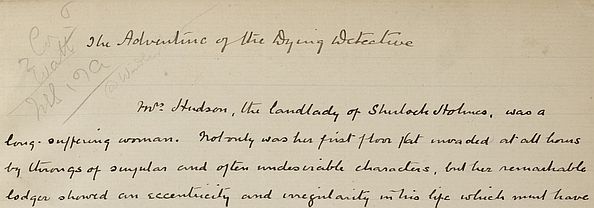
Complete manuscript, 18 pages, bound.
Lent by Dr. Constantine Rossakis.
Photo © Private Library of Constantine Rossakis, M.D.
The Illustrious Client (manuscript, 1924)
Conan Doyle changed the story title on a number of his Holmes manuscripts, striking out an early version and replacing it with his preferred choice. However, in this manuscript he leaves two titles intact, marking the second as "Alternative title: The Adventure of the Blue Saucer." He finished this story in July 1924 and it was published using the first title in November 1924.
The author typically signed his manuscripts as "A. Conan Doyle" or "Arthur Conan Doyle," but in what might be a unique instance, signed this tale as "Sir A Conan Doyle." For more details, see The Illustrious Client Manuscript page or read my paper "An Illustrious Manuscript" in the Autumn 2007 Baker Street Journal.
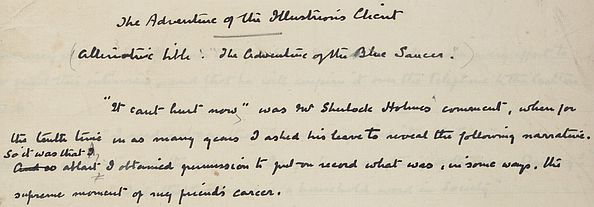
Complete manuscript, 38 pages, bound.
On loan from the National Library of Scotland.
Photo © National Library of Scotland.
First Editions and Other Publication Highlights (by date)
While Sherlock Holmes is a multimedia phenomenon, he first gained worldwide fame through stories in magazines and books. Some of these are now incredibly rare and valuable. A few highlights on display at the Museum of London appear below.
Beeton's Christmas Annual 1887
Sherlock Holmes first appeared in 1887 in Beeton's Christmas Annual. Called "the most expensive magazine in the world," only eleven complete copies still exist, and two of the best are on display at the Museum of London.
Some copies of Beeton's 1887 lack the "I" of "I fancy that he suspected..." on page 90. In his Winter 2011 BSJ article, Constantine Rossakis found that copies lacking the "I" are the true first edition, first issue of this magazine.
The Beeton's Christmas Annual 1887 census has more about the magazine and all known extant copies, including some that are incomplete. It also includes more details about copy R21 (at left), and copy R23.
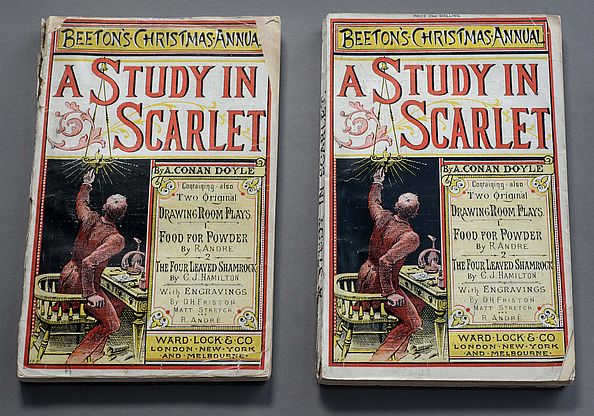
Two printings of A Study in Scarlet in Beeton's Christmas Annual 1887.
Copy R21 (left): First issue, without "I," lent by Dr. Constantine Rossakis.
Copy R23 (right): Second issue, with "I," lent by the Arthur Conan Doyle Collection-Lancelyn Green Bequest, Portsmouth.
Photos © Constantine Rossakis, M.D. and Portsmouth Museum Service.
A Study in Scarlet (1888)
Ward, Lock & Co. published the first separate book edition of A Study in Scarlet in July 1888. This small and fragile 7x5 inch book had paper covers glued to the spine and included six line drawings for the story by Charles Doyle, the author's father.
Shown here is the rare first impression. A second impression, issued in March 1889, came with a slightly different cover.
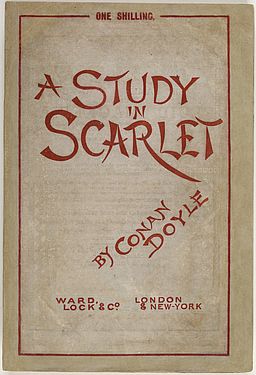
A Study in Scarlet, 1888, First British Edition.
Lent by Dr. Constantine Rossakis.
Photo © Private Library of Constantine Rossakis, M.D.
The Sign of Four (1892)
Spencer Blackett published the first British book edition of The Sign of Four in October 1890. After George Newnes began publishing the Holmes short stories in his Strand Magazine, Newnes acquired the copyright to The Sign of Four and began issuing new impressions of the book that included this version with a pictorial front cover.
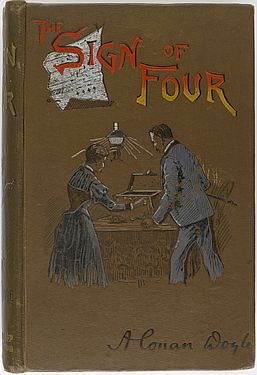
The Sign of Four, 1892, George Newnes Ltd.
Photo © Museum of London
Artwork
See my separate page about Sidney Paget Artwork and Artifacts at the Museum of London.
Exhibition Information & Recommendations
The Museum of London:
Sherlock Holmes: The Man Who Never Lived and Will Never Die
http://www.museumoflondon.org.uk/Sherlock
Internet Archive of Museum pages
17 October 2014 – 12 April 2015
Not since the 1951 Festival of Britain has there been such an extensive exhibition of rare Sherlock Holmes material. It spans from the origins of Holmes through the BBC Sherlock of today, and offers perspectives that will fascinate both new fans and long-time Sherlockians. Alex Werner, head of history collections at the Museum of London calls it "a once-in-a-lifetime opportunity to see such a diverse collection of Sherlock Holmes artefacts and materials under one roof." I completely agree.
Videos About It Recommended News Articles Exhibition Overview Catalogue
Videos About the Exhibition
Sherlock Holmes exhibition launch party (Museum of London; YouTube, 2 minutes)
The launch party for the opening of the exhibition, with some shots of the exhibition and comments by celebrities including Mark Gatiss, Natalie Dormer, Richard Doyle (great-nephew of Conan Doyle), and others.
Rare Sherlock Holmes memorabilia on display in new exhibit (Press Association, YouTube, 2 minutes)
Interview with curator Pat Hardy about the exhibition, including some nice shots of manuscript notes and other items.
Sherlock Holmes exhibition opens in London (CCTV News, YouTube, 2 minutes)
News feature overview about Holmes and the exhibition, with many shots from the interior and brief comments by curator Alex Werner. A 5-minute version, without voiceover but with written storyline, appears on the AP Archive.
Sherlock Holmes and the Art of Victorian London (Museum of London; YouTube, 3 minutes)
Alex Werner and Pat Hardy talk about London while showing many paintings, drawings, and photos of the city on display at the exhibition.
Recommended News Articles
I've read more than 50 news reports about the exhibition, and recommend the following.
Sherlock Holmes: Museum of London Exhibition (The Telegraph, October 2014)
Picture gallery with 14 large photos from the exhibition.
The changing face of Sherlock Holmes (BBC World Service, 16 October 2014)
Good summary of the exhibition.
Sherlock Holmes At The Museum Of London (The Londonist, 17 October 2014)
See especially the photo of dancing men figures outside the museum.
Sherlock Holmes exhibition reveals Conan Doyle's first plots… (The Guardian, 16 October 2014)
Focuses on the early notes for A Study in Scarlet and on the Paget drawings
First manuscript page… (The Mail Online, 4 October 2014)
About The Sign of Four manuscript with several very large related photos
Sherlock-Topia at Museum of London (Huffington Post UK, 17 October 2014)
A blogger's personal impressions of the exhibition.
Exhibition Overview
The largest Sherlock Holmes exhibition since the 1951 Festival of Britain includes five main sections
Sherlock Holmes Reinvented
Holmes can never die, in part because each generation reinvents him with new adaptations on stage, screen, the radio, and pastiches. This section focuses on such adaptations and includes radio plays, film posters, and a wall of screens showing TV and film versions of the detective.
The Genesis of Sherlock Holmes
This section deals with the beginnings of Sherlock Holmes and includes manuscripts, first editions, drawings, and artifacts. While it contains many of the early Sherlockian rarities, some items (including some manuscripts) are in other sections.
The London of Sherlock Holmes
Sherlock Holmes lived in London, and the city is an essential "character" in many of the tales. This section provides many different views of London through paintings, photographs, maps and other material that highlight the city overall and key locations from the Holmes adventures.
The Many Sides of Sherlock Holmes
Holmes was a mastermind, a forensic scientist, a Bohemian soul, a model Englishman and a master of disguise. Items in this section illustrate each of these traits, and include material from the BBC Sherlock Holmes. The Bohemian area displays the first page of the manuscript for The Sign of the Four, which describes the detective's use of cocaine.
The Immortal Sherlock Holmes
More than 125 years after the first Holmes story appeared, he is more popular than ever. The final section of the exhibition includes manuscripts for "The Empty House," where Conan Doyle brought Holmes back from the dead, and the manuscript of one of his last cases, "The Illustrious Client."
Exhibition Catalogue
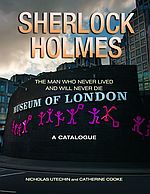
Two publications provide a record of this magnificent exhibition. The catalogue, published in April 2015 after the exhibition closed, provides photos and descriptions of many of the items on display. The companion book includes six scholarly essays on topics and themes from the exhibition. Both are worth getting.
The 96-page catalogue walks you through the exhibition in the approximate order in which visitors should have viewed this material. Its text goes well beyond simple descriptive catalogue entries, and provides a real sense of visiting the exhibition. In addition, it includes commentary by Glen Miranker and Constantine Rossakis on a number of the Sherlockian treasures they loaned for this exhibition. With more than 35 photos, most of which are large and in full color, this catalogue is a treasure in itself for anyone interested in Sherlock Holmes. Available only from the BSJ website.
My earlier review provides details about the exhibition companion book. While both the book and the catalogue are roughly 10 x 7.5 inches, the book is a 251-page hardcover while the catalogue is a 96-page paperback. Both include color illustrations, although the book has much more about the general art on display, while the catalogue prioritizes Sherlockian material, including Paget and Steele drawings, manuscripts, and rare first editions. However, the book does include a color photo of a Paget Hound of the Baskervilles drawing not displayed at the exhibition.
My web pages about the exhibition, including the information above and my page on Sherlockian artwork and artifacts, provide highlights of the material. The catalogue covers many more items, has larger photos of many of these highlights, and has additional information on many of the items that I listed.
For those who could not visit the exhibition, I recommend you do all of the following:
- View these manuscript and first edition highlights above
- View these artwork and artifacts highlights
- Watch a couple of the videos listed above
- Buy the Catalogue at the BSJ website
Completists and those interested in a broader sense of London and of the exhibition should also get the Companion book.
Acknowledgements
My congratulations and thanks to Alex Werner and Andrew Scott at the Museum of London for putting on this great exhibition and providing details about it. Also thanks to Elizabeth Fuller, Jon Lellenberg, Glen Miranker, Alexander Orlov, and Costa Rossakis for their help and information.
Related Pages
Sidney Paget Artwork & Artifacts at the Museum of London.
Origins of Sherlock: Notes for A Study in Scarlet with Sherrinford Holmes
Census of original Sherlock Holmes Manuscripts
Census of original Sidney Paget Drawings
Other Conan Doyle rarities like Beeton's Christmas Annual 1887.
Lists of each year's best Sherlock Holmes books & DVDs, the most famous Sherlock Holmes quotes, and more Top 10 Lists.
Return to Manuscripts Home page and Introduction
Vers. 2.1ax-RN Original work
Copyright ©2015
Randall Stock. All Rights Reserved.